The Necklace Nebula is a planetary nebula located 15,000 light-years away in the northern constellation Sagitta. It has an apparent diameter of 0.35 arcminutes and an apparent magnitude of 10.6. The nebula is catalogued as PN G054.203.4 and IPHASXJ194359.5+170901. It was produced about 10,000 years ago when an aging giant star came too close to its binary companion.
The Necklace Nebula was named for its unique appearance, which resembles that of a necklace. It is composed of a knotty ring and faint lobes and caps that appear perpendicular to the ring. The lobes are produced by a fast collimated outflow. The ring has a long axis of about 13 arcseconds, corresponding to a physical size of 12 trillion miles. It expands at a speed of 28 km/s.
The polar caps appear about 1 arcminute from the central star. They expand at around 100 km/s and have a kinematical age that is twice the age of the ring. This may indicate mass transfer from the primary onto the secondary companion in the nebula’s central star system.
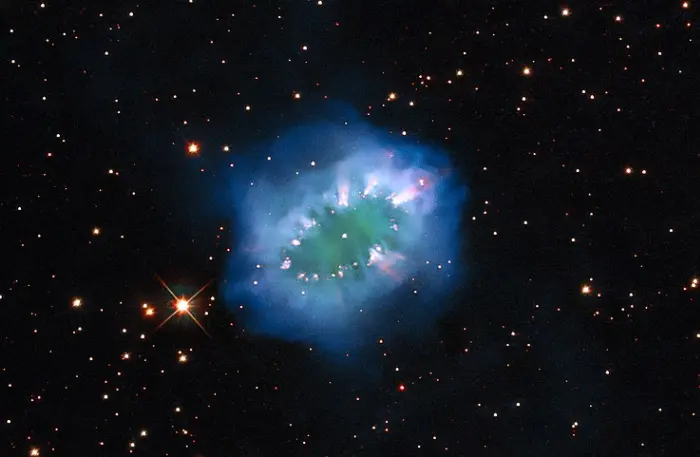
The interaction of two doomed stars has created this spectacular ring adorned with bright clumps of gas — a diamond necklace of cosmic proportions. Fittingly known as the Necklace Nebula, this planetary nebula is located 15 000 light-years away from Earth in the small, dim constellation of Sagitta (The Arrow). The Necklace Nebula — which also goes by the less glamorous name of PN G054.2-03.4 — was produced by a pair of tightly orbiting Sun-like stars. Roughly 10 000 years ago, one of the aging stars expanded and engulfed its smaller companion, creating something astronomers call a “common envelope”. The smaller star continued to orbit inside its larger companion, increasing the bloated giant’s rotation rate until large parts of it spun outwards into space. This escaping ring of debris formed the Necklace Nebula, with particularly dense clumps of gas forming the bright “diamonds” around the ring.The pair of stars which created the Necklace Nebula remain so close together — separated by only a few million kilometres — that they appear as a single bright dot in the centre of this image. Despite their close encounter the stars are still furiously whirling around each other, completing an orbit in just over a day. The Necklace Nebula was featured in a previously released Hubble image, but now this new image has been created by applying advanced processing techniques, making for a new and improved view of this intriguing object. The composite image includes several exposures from Hubble’s Wide Field Camera 3. Image credit: ESA/Hubble & NASA, K. Noll (CC BY 4.0)
The dense clumps of gas in the ring appear as bright knots embedded in the nebula. These knots look like diamonds in a necklace. They appear so bright due to absorption of the intense ultraviolet light from the central stars.
Planetary nebulae are formed when evolved red giant stars come to the end of their life cycles and expel their outer envelopes. As the clouds of ejected material expand, they are illuminated by the hot stellar remnants.
These nebulae are relatively short-lived. They typically last only about 10,000 years. The expanding gas clouds eventually dissipate into the surrounding space and the central stars cool and gradually fade as dim white dwarfs.
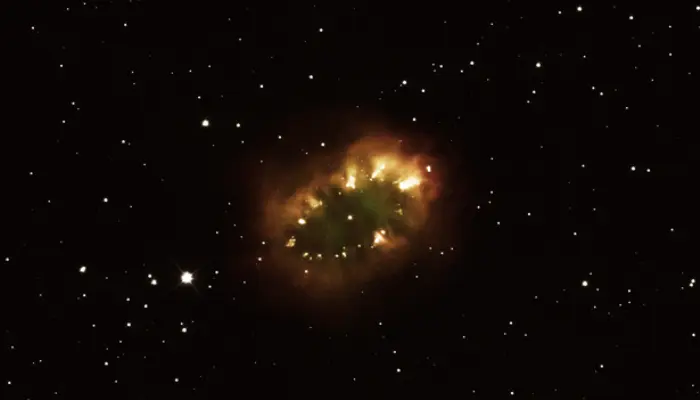
Necklace Nebula, image credit: Wikimedia Commons/Pelligton (CC BY-SA 4.0)
The unique appearance of the Necklace Nebula was produced by not one but two stars. These stars form a common envelope binary system. As the central red giant expanded in a late stage of its life, it engulfed its Sun-like companion. The companion continued orbiting within the giant star, increasing the latter’s rotational velocity. As the giant kept spinning faster, it lost much of its gaseous envelope due to centrifugal force. Most of the expelled gas escaped along the giant’s equator, producing a ring-like shape.
The two stars at the centre of the Necklace Nebula have an orbital period of only 1.2 days. They are separated by 5 solar radii, or only a few million kilometres. The primary component, the hot post-AGB star, has a mass between 0.5 and 1 solar masses, while the secondary, a Sun-like star, has a mass of up to 1 solar mass. The stars appear as a single point of light in images of the nebula.
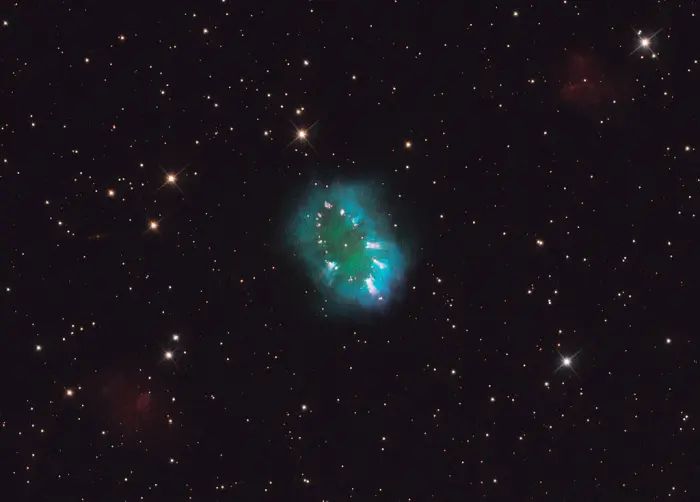
A giant cosmic necklace glows brightly in this NASA/ESA Hubble Space Telescope image. The object, aptly named the Necklace Nebula, is a recently discovered planetary nebula, the glowing remains of an ordinary, Sun-like star. The nebula consists of a bright ring, measuring about two light-years across, dotted with dense, bright knots of gas that resemble diamonds in a necklace. The knots glow brightly due to absorption of ultraviolet light from the central stars. A pair of tightly orbiting stars produced the nebula, also called PN G054.2-03.4. About 10 000 years ago one of the aging stars ballooned to the point where it engulfed its companion star. The smaller star continued orbiting inside its larger companion, increasing the giant’s rotation rate, so that the bloated star span so fast that a large part of its gaseous envelope expanded into space. Most of the gas escaped along the star’s equator, producing a ring. The bright knots are dense gas clumps in the ring. The stars are furiously whirling around each other, completing an orbit in a little more than a day. For comparison, Mercury, the innermost planet of our Solar System, orbits the Sun in 88 days. The Necklace Nebula is located 15 000 light-years away in the constellation of Sagitta (The Arrow). In this composite image, taken on 2 July, Hubble’s Wide Field Camera 3 captured the glow of hydrogen (blue), oxygen (green), and nitrogen (red). Image credit: NASA, ESA and the Hubble Heritage Team (STScI/AURA) (CC BY 4.0)
Facts
The Necklace Nebula was discovered during the Isaac Newton Telescope Photometric H-alpha Survey (IPHAS) in 2005. IPHAS was a hydrogen alpha survey of planetary nebulae in the North Galactic Plane carried out with Isaac Newton Telescope (INT) in the Canary Islands in Spain.
A 2010 study led by Romano L. M. Corradi of the Instituto de Astrofísica de Canarias in Spain found evidence for binarity of the central star. The international team of astronomers found an orbital period of 1.16 days for the star system. They derived a kinematical age of 5,000 years for the nebula’s ring and up to 13,000 for the polar caps. They described the object as a “high-excitation planetary nebula with remarkable characteristics.”
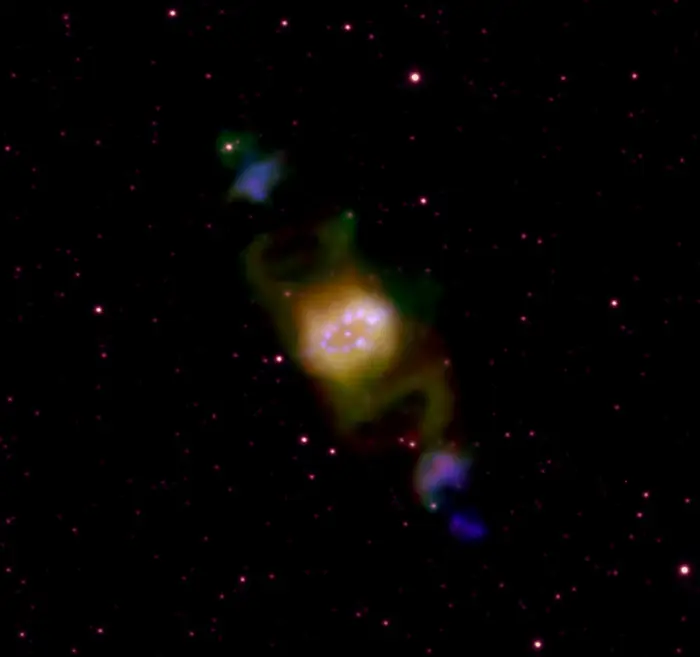
Astronomical image of the ‘Necklace’ Nebula, discovered by the IPHAS survey. Image: Isaac Newton Telescope, credit: Wikimedia Commons/Nwright6302 (PD)
Location
The Necklace Nebula lies in the northern sky. It is easy to find because it appears near the distinctive constellation figure of Sagitta, the Arrow. The constellation Sagitta lies with the Summer Triangle, formed by Vega in Lyra, Altair in Aquila, and Deneb in Cygnus.
The star pattern of the celestial Arrow appears roughly halfway between Altair at the Eagle’s head or neck and Albireo at the Swan’s beak. The nebula lies near the stars Sham (Alpha Sagittae) and Beta Sagittae. At declination +17°, it is visible from virtually any place on Earth for at least part of the year.
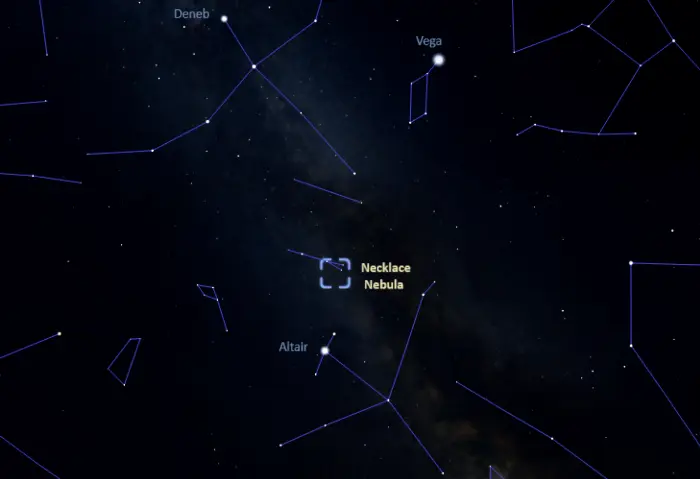
The location of the Necklace Nebula (PN G054.203.4), image: Stellarium
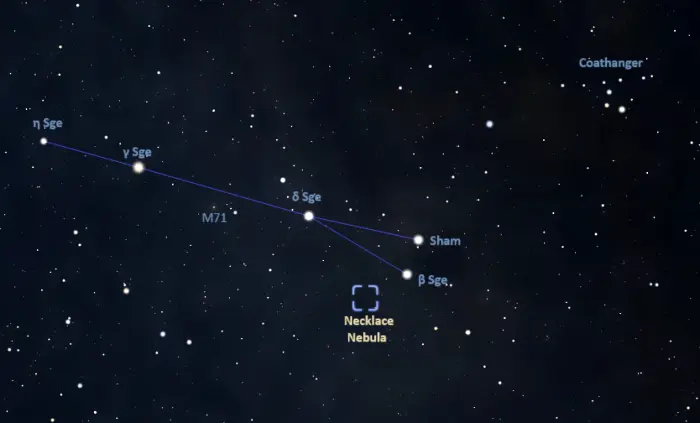
Necklace Nebula location, image: Stellarium
The best time of the year to observe the Necklace Nebula and other deep sky objects in Sagitta is during the month of August, when the constellation appears high above the horizon in the evening.
Necklace Nebula
| Constellation | Sagitta |
| Right ascension | 19h 43m 59.5114618200s |
| Declination | +17° 09′ 00.963778248″ |
| Apparent magnitude | 10.6 |
| Apparent size | 0.35′ |
| Radius | 4.4 light-years (1.35 parsecs) |
| Distance | 15.0 ± 3.6 kilolight-years (4.6 ± 1.1 kiloparsecs) |
| Names and designations | Necklace Nebula, PN G054.2-03.4, IRAS 19417+1701, IPHASXJ194359.5+170901, AKARI-FIS-V1 J1943591+170903, USNO-B1.0 1071-00528101, WISEA J194359.51+170900.9, WISE J194359.51+170901.1, Gaia DR2 1820974088126464384, Gaia DR3 1820974088126464384 |